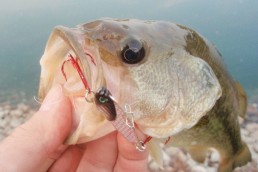Attraction and Trigger: Blade Baits are First-rate Catchers
SHARE THIS POST
Though I am nearing my seventh decade of existence, bass fishing for me remains a learning experience. In trying to outsmart the wily smallmouths and the lumbering largemouth bass, I have tried a little bit of everything, including crankbaits, artificial worms, inline spinners, spinnerbaits, minnow lures, jerkbaits and any number of topwater lures. Every one of them has caught fish, and sometimes many, but I am constantly searching for something “new” that the fish have not seen before.
Since almost 90 percent of my smallmouth fishing is carried out in river systems, I have declined the use of live bait. Smallies are such aggressive feeders, live bait like worms or minnows often are inhaled quickly and deeply. And, since I try to release 100 percent of the bronzebacks that I land, I don’t want to take the risk of killing even one.
The same goes for the pond-, lake-, reservoir- and river-dwelling largemouths. With its cavernous maw, it is an easy task for them to bite then swallow a small, worm-laden fish hook—I try to avoid this at all costs.
Finally, I happened to stumble across and have begun to utilize the old standby blade baits.
What are they, you ask? Well, blade baits have been around for a little over 50 years, when Heddon introduced the first Sonar lure. For some unknown reason they only caught on with a small group of anglers who used them mainly for walleyes in the “Great Far North.”
I knew about the old Sonar, though I do not recall ever purchasing one. Then in recent years, I began to take an interest in saugeye fishing at one of the big reservoirs not too far from my home. The lure of choice for the local anglers was a blade bait known as the VIB“E.” Shaped like a minnow and constructed with a metal weight-forward body, it sported two treble hooks and a three-position line tie with a small snap. They jigged it, the saugeyes bit and everyone was happy. I caught a few fish for myself and also was thrilled with my success.
The more I used the lure, the more I thought about it: I wonder if both bass species would also be attracted by its “fishy-looking” appeal. I decided to give it a whirl, and I’m glad I did.
Are you enjoying this post?
You can be among the first to get the latest info on where to go, what to use and how to use it!
Smallmouths live and die by the current in a river. They lie in wait on the edges and dart into the current to grab any morsel of food that appeals to them. Largemouths tend to lurk near cover and grab whatever tempting bit of food that happens to swim, crawl or struggle by.
The strength of any blade bait is that it can be utilized both as an attracting and triggering lure. Whether it is a ViB”E,” a Reef Runner Cicada, a Buckeye Lures Jiggin’ Blade, a Cordell Gay Blade, or my very favorite, the Bass Pro Shop XPS, these lures offer tremendous vibration when cast and retrieved in a river system or lake. This vibration also really proves its merit in stained or muddy waters when the fish must use their sensitive lateral lines to detect prey. When a blade bait is jigged, the small metal body swims in a tight circle at the depth the fish are at. While it is circling, it also is emitting vibration and throwing quite a bit of flash.
In addition, many blades, such as the XPS, offer a holographic finish that really reflects the sunlight. And, again, serves as both an attractor and trigger, especially for fish that might be in a negative mood.
As one who definitely subscribes to the theory that fish can become “conditioned” to the same old lures they have seen before, I truly believe that showing them a blade bait can and does result in more strikes.
How can I measure this? Two reasons (ways): I catch as many or more fish than I ever did, and, when I tell other anglers that I caught them on a blade bait their reply is, “What’s that?” Obviously, they are not throwing them.
Smallmouths most likely will be found in the deeper holes of rocky rivers or at the base of fast-flowing riffles. And once again, this is where the blade bait shines. With its heavy body, it will sink quickly and reach the depths where the fish are holding. If snagging is a problem, just keep your rod tip a bit higher and reel a bit faster. Do not worry. You cannot retrieve your lure faster than a smallmouth can swim to catch it. Also, with their sensitive lateral lines, the largemouths can “hear” the vibrations emitted by the fast wiggling bit of metal. Both bass will attack and provide a spirited fight.
If you have not tried these interesting lures, pick up a few and give them a try.
MWO
SHARE THIS POST
Did you enjoy this post?
You can be among the first to get the latest info on where to go, what to use and how to use it!
John Bennett
John Bennett is a retired history teacher, historical re-enactor, father and grandfather. As a four-season outdoorsman, his passion is waterfowl hunting and fishing for smallmouth bass. He lives in Ohio and spends quite a bit of time in his primitive log cabin, which he built.



